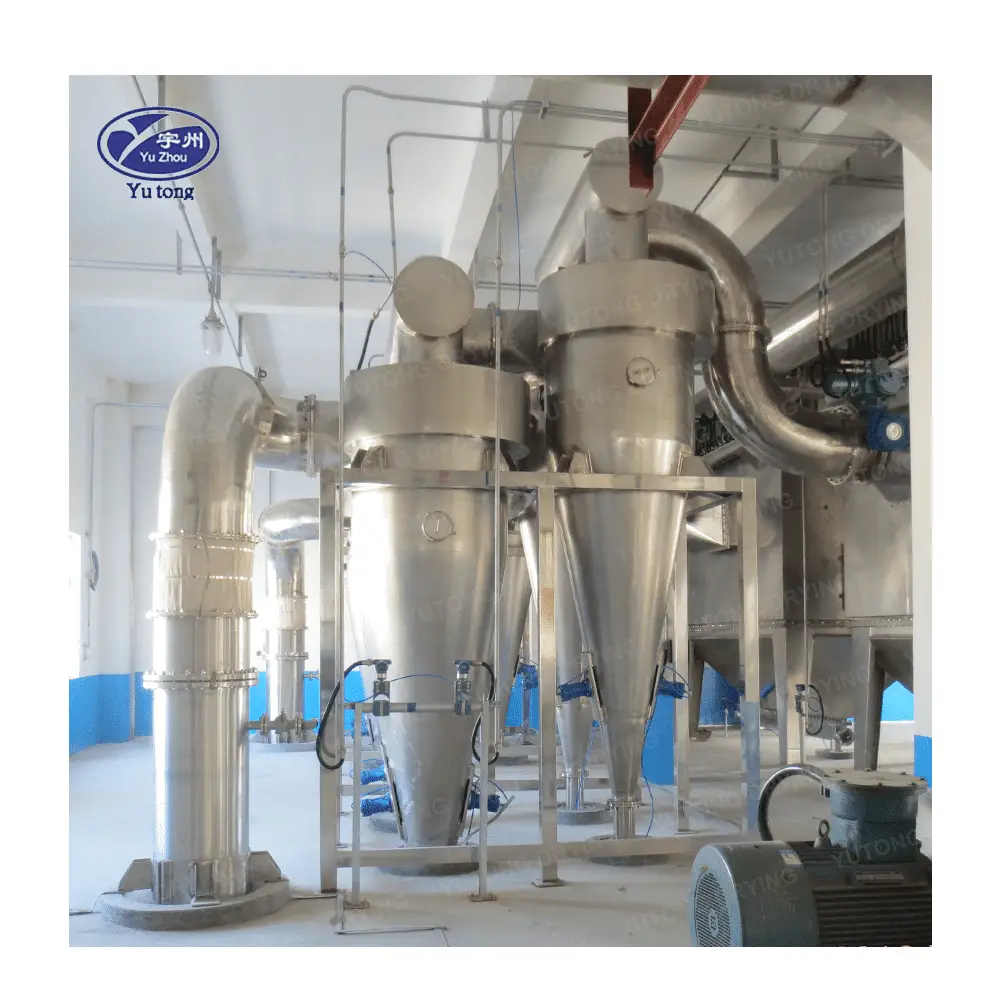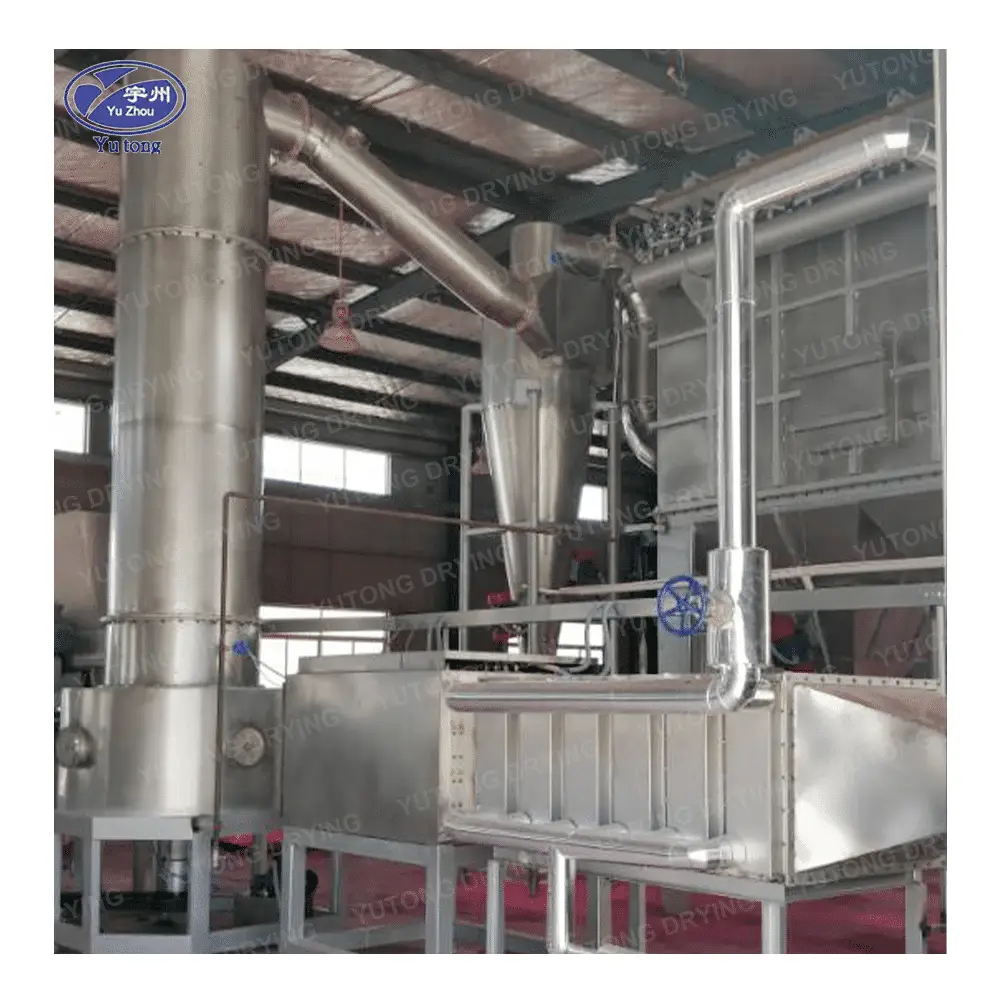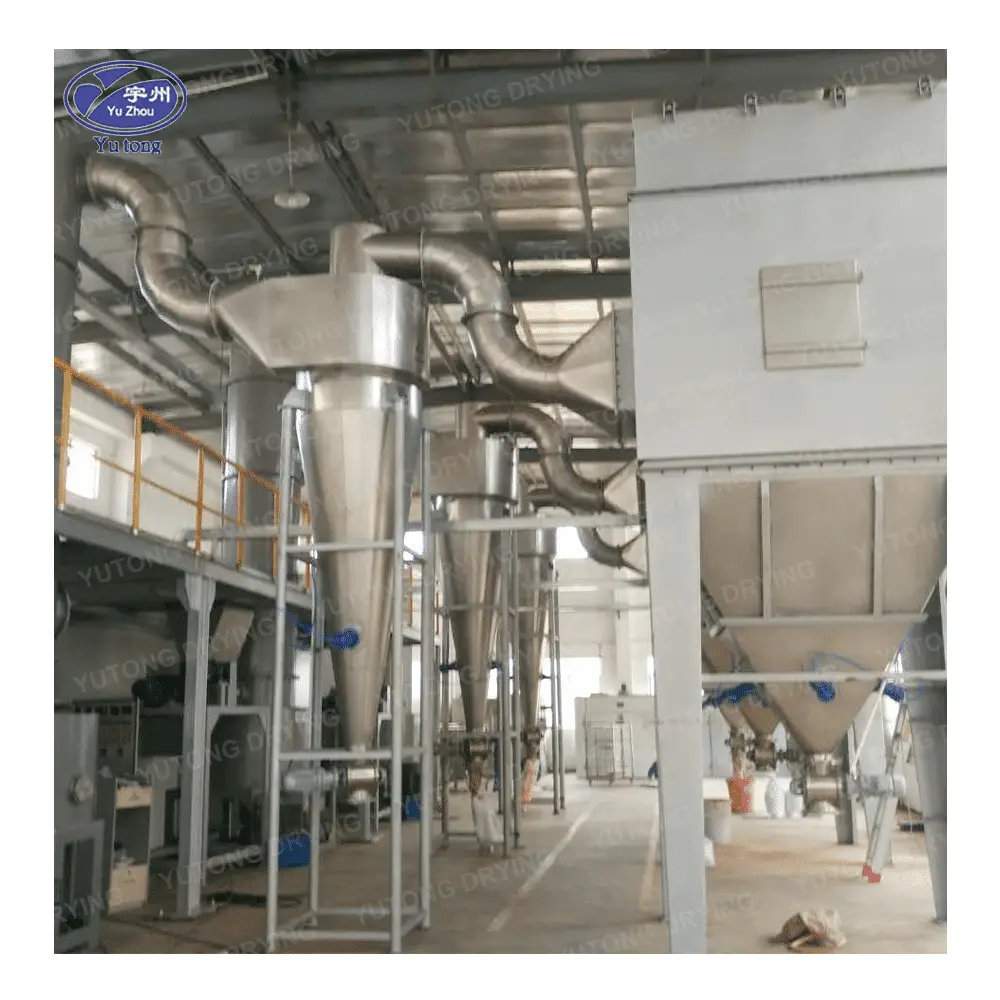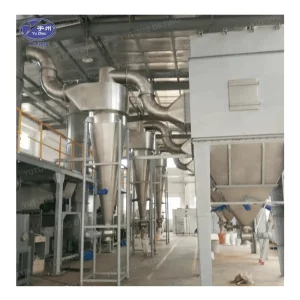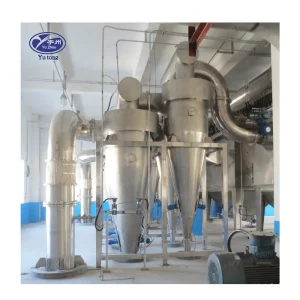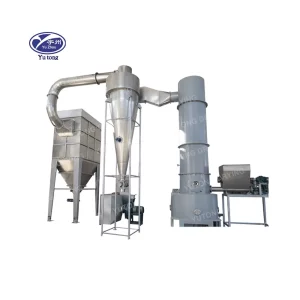Table of Contents
Product Detail
In industrial drying, choosing the right equipment is crucial for efficiency and cost-effectiveness. One of the most versatile and widely used types of dryers in industrial applications is the rotary flash dryer. This article will delve into the workings, advantages, and applications of rotary flash dryers and compare them with other drying methods to help you make an informed decision for your business needs.
What is a Rotary Flash Dryer?
A rotary flash dryer is an industrial dryer designed to rapidly remove moisture from materials. It combines the features of both rotary and flash dryers to provide an efficient drying solution. This equipment is beneficial for drying materials that are sensitive to heat or require a short drying time.
How Does a Rotary Flash Dryer Work?
The rotary flash dryer operates by passing hot air through a rotating drum where the material to be dried is fed. The drum’s rotation plays a critical role in ensuring the material is evenly exposed to the hot air, which rapidly evaporates the moisture content. The dried material is then collected from the other end of the drum, ready for further processing or packaging.
The process begins with the feed mechanism introducing the wet material into the drum. As the drum rotates, it creates a lifting action that spreads the material evenly across the hot air stream. This action ensures that every particle is uniformly dried, reducing the risk of uneven drying, which can lead to quality issues.
A hot air generator generates the hot air used in the drying process. This component is crucial as it needs to provide a consistent temperature to efficiently evaporate moisture without compromising the quality of heat-sensitive materials. The hot air passes through the material, carrying the evaporated moisture out through the exhaust system.
Key Components of a Rotary Flash Dryer
A rotary flash dryer is composed of several essential components, each playing a vital role in its operation:
- Rotating Drum: The core component where the drying process takes place. It needs to be robust and well-designed to handle the mechanical and thermal stress during operation.
- Hot Air Generator: Provides the necessary heat for moisture evaporation. This component must be efficient and capable of maintaining a stable temperature to ensure consistent drying results.
- Feed Mechanism: Introduces the wet material into the drum. It must be designed to prevent clogging and ensure a smooth, continuous feed to the drum.
- Exhaust System: Removes the evaporated moisture from the drum. It is crucial for maintaining the efficiency of the drying process and preventing moisture build-up inside the drum.
- Control Panel: Allows operators to control and monitor the drying process. An intuitive and responsive control panel can significantly enhance the operation’s efficiency and flexibility, allowing for adjustments to be made in real time.
Advantages of Using a Rotary Flash Dryer
Rotary flash dryers offer several benefits that make them a preferred choice in various industries:
Rapid Drying
The design of rotary flash dryers allows for quick evaporation of moisture, making them ideal for materials that require short drying times. The rotating action ensures even exposure to hot air, enhancing the drying efficiency. This rapid drying capability can significantly boost production rates, allowing industries to meet high demand without compromising on quality.
The speed of drying also means that there’s less opportunity for thermal degradation of the material, which is particularly important for heat-sensitive products. This attribute ensures that the dried product maintains its desired physical and chemical properties, which is vital for industries like pharmaceuticals and food processing.
Versatility
These dryers can handle a wide range of materials, from fine powders to larger particles. This versatility makes them suitable for industries like pharmaceuticals, chemicals, and food processing. The ability to process diverse materials means that a single rotary flash dryer can be adapted for different production lines, enhancing its utility and cost-effectiveness.
Rotary flash dryers’ adaptability also extends to their ability to handle materials with varying moisture contents. Whether dealing with wet slurries or dry powders, these dryers can be adjusted to provide optimal drying conditions, ensuring consistent quality and efficiency across different batches.
Energy Efficiency
Rotary flash dryers are designed to maximize energy use, reducing operational costs. The efficient heat transfer and rapid drying process mean less energy is required to achieve the desired moisture levels. This not only cuts down on energy bills but also contributes to a lower carbon footprint, making these dryers an environmentally friendly choice.
Additionally, the advanced control systems in modern rotary flash dryers allow for precise regulation of temperature and airflow, further optimizing energy use. This level of control ensures that no energy is wasted and the drying process is as efficient as possible.
Space-Saving Design
Rotary flash dryers are more compact than traditional rotary dryers, making them suitable for facilities with limited space. Their streamlined design allows them to be integrated into existing production lines without the need for significant layout changes, saving both time and money during installation.
This compact design does not compromise performance, however. Rotary flash dryers maintain high throughput rates and drying efficiency despite their smaller footprint, making them ideal for both large-scale operations and more petite, space-constrained facilities.
Applications of Rotary Flash Dryers
Rotary flash dryers are used in various industries due to their efficiency and adaptability:
- Chemical Industry: Used for drying chemicals like ammonium sulfate, calcium carbonate, and more. The precision of drying and the ability to handle sensitive materials make them indispensable in chemical processing.
- Pharmaceuticals: Ideal for drying heat-sensitive pharmaceutical ingredients. They ensure that active ingredients retain their efficacy and stability, which is crucial for patient safety and regulatory compliance.
- Food Processing: Employed in drying starches, spices, and other food products. The ability to quickly remove moisture without affecting flavor or nutritional value makes them valuable in food production.
- Minerals: Suitable for drying minerals like clay, gypsum, and more. Their robustness and efficiency make them ideal for handling abrasive and heavy materials found in mineral processing.
Rotary Dryer vs. Flash Dryer: A Comparative Analysis
Understanding the differences between rotary dryers and flash dryers can help in selecting the right equipment for your needs.
Rotary Dryer
- Operation: Uses a rotating drum to dry materials with hot air. The process is generally slower than flash drying but can handle larger volumes.
- Best For: Large volumes of material that are not heat-sensitive. Ideal for industries where throughput is more critical than drying speed.
- Advantages: Handles a variety of materials, simple to operate. The straightforward operation makes them a popular choice for many industrial applications.
Flash Dryer
- Operation: Uses a short burst of hot air to dry small particles rapidly. This method is faster than rotary drying and is particularly effective for fine powders.
- Best For: Fine powders and heat-sensitive materials. The quick drying times minimize the risk of thermal degradation.
- Advantages: Quick drying times and minimal thermal degradation. This makes flash dryers suitable for high-value or sensitive products.
Rotary Flash Dryer
It combines the principles of rotary and flash dryers, offering a balance of rapid drying and versatility. This makes it suitable for a wide range of applications, offering the best of both worlds. Rotary flash dryers’ hybrid nature allows them to deliver efficient performance across various materials and production needs, providing a flexible solution for many industries.
How to Choose the Right Dryer for Your Needs
When selecting a dryer, consider the following factors:
- Material Characteristics: Consider the size, shape, and sensitivity of your material. Understanding these properties will help you select a dryer that provides optimal drying conditions without damaging the material.
- Moisture Content: Determine the initial and desired final moisture content. This will influence the drying time and temperature settings required to achieve the desired results.
- Production Capacity: Assess the volume of material you need to process. Ensure that the dryer can handle your production needs without causing bottlenecks in your operation.
- Space Constraints: Evaluate the available space for installation. Consider not only the footprint of the dryer but also the space required for maintenance and operation.
- Energy Consumption: Consider the energy efficiency of the dryer. Opt for models that offer advanced control systems to minimize energy use and reduce operational costs.
Conclusion
Rotary flash dryers are an excellent choice for industries seeking efficient, versatile, and rapid drying solutions. Their ability to handle a variety of materials and their energy-efficient design make them a valuable asset in industrial drying processes. By understanding their advantages and comparing them with other drying methods, you can make an informed decision that meets your production needs and enhances operational efficiency. Whether you are in the chemical, pharmaceutical, food, or mineral industry, a rotary flash dryer could be the perfect addition to your processing line. Their adaptability, combined with their compact design and energy efficiency, ensures that they can meet the demands of modern industrial applications, providing a reliable and cost-effective solution for your drying needs.
Specifications
|
Type
|
Barrel diameter(mm)
|
Main machine dimensions(mm)
|
Main machine power(Kw)
|
Treatment wind capacity(m³/h)
|
Water evaporation quantity(kg/h)
|
|
SXG-2
|
200
|
250×2800
|
5-9
|
300-800
|
10-20
|
|
SXG-3
|
300
|
400×3300
|
8-15
|
600-1500
|
20-50
|
|
SXG-4
|
400
|
500×3500
|
10-17.5
|
1250-2500
|
25-70
|
|
SXG-5
|
500
|
600×4000
|
12-24
|
1500-4000
|
30-100
|
|
SXG-6
|
600
|
700×4200
|
20-29
|
2500-5000
|
40-200
|
|
SXG-8
|
800
|
900×4600
|
24-35
|
3000-8000
|
60-600
|
|
SXG-10
|
1000
|
1100×5000
|
40-62
|
5000-12500
|
100-1000
|
|
SXG-12
|
1200
|
1300×5200
|
50-89
|
10000-20000
|
150-1300
|
|
SXG-14
|
1400
|
1500×5400
|
60-105
|
14000-27000
|
200-1600
|
|
SXG-16
|
1600
|
1700×6000
|
70-135
|
18700-36000
|
250-2000
|
Applications
Applicable Industries:
Manufacturing Plant, Machinery Repair Shops, Food & Beverage Factory, Farms, Retail, Energy & Mining, Food & Beverage Shops

